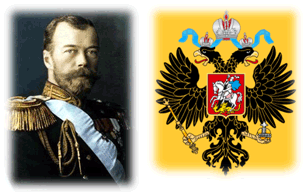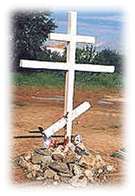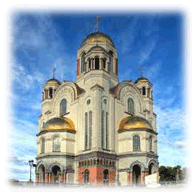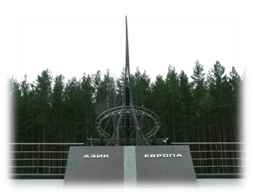Russian Imperial Romanov Family Exhumed
by Edward J. "Ed" Steenberg
Saint Paul Police Historical Society
It was one of the great mysteries of the 20th century. In the early morning hours on the 17th of July in 1918 a Bolshevik firing squad executed Russia's last tsar, Nicholas II, together with his wife, four young daughters and son in the home of a local merchant, Nikolay Nikolayevich Ipatiev (also known as "Ipatiev House" or "The House of Special Purpose"), in the Siberian mining town of Yekaterinburg 1. The remains of the Romanov family were exhumed in 1991, formally identified using DNA samples, and reburied in a St. Petersburg cathedral. The unmarked grave had been located about 12 miles north of Yekaterinburg in "Pig's Meadow" on the 30th of May in 1979 by geologist Aleksandr Avdonin and researcher (writer/filmmaker) Geli Ryabov, but the exhumation did not take place until the 11th of July in 1991, with the tacit support of Boris Nikolayevich Yeltsin... inaugurated as the first freely-elected president of the new Russian Federation the previous day. On the 25th of December, in the same year, Mikhail Sergeyevich Gorbachev resigned as president of the USSR and, in effect, the Soviet Union ceased to exist.

Tsar Nicholas II of Russia
After the shooting of the Romanov family, the deceased were transported to the "Four Brothers Mine" near the village of Koptyak, about 9.5 miles north of Yekaterinburg. The bodies were stripped and dumped into a 9' deep water-filled pit ("Ganya's Pit"). Because the corpses were not completely hidden from view and realizing that the burial site was no longer a secret, the remains were removed by the Bolsheviks from that location the next night and buried in "Pig's Meadow". Today, a monastery and seven chapels adorn the site at the former pit mine, one for each member of the royal family, and a church has been built on the site of the assassination. Exactly 80 years after their execution by Bolsheviks on the 17th of July in 1998, the last Tsar of Russia and his family were buried in the crypt of St. Petersburg's St. Peter and Paul Cathedral.
Why hide the bodies? There was a concern by the Bolsheviks that the location of the Tsar's execution and burial place would become a place of pilgrimage for a "White" Russian (anti-communist) movement.
But two of the Romanovs were not found in the initial exhumation. The bodies of the tsar's heir, Prince Alexei, 13, and one of his four sisters were missing. Archival evidence suggested the pair had been buried near, yet away from the others. But repeated digs at the location on the outskirts of Yekaterinburg failed to reveal their resting place. Recovered in the initial dig were the bodies of 50 year-old Tsar Nicholas II, his 46 year-old wife Alexandra Feodorovna (granddaughter of Queen Victoria of the United Kingdon), daughters Olga Nikolaevna, 22, Tatyana Nikolaevna, 21, and either Maria Nikolaevna, 19, or Anastasia Nikolaevna, 17, as well as four retainers who had voluntarily chosen to remain with the family – the tsar's personal physician Evgeny Bolkin, his wife's maidservant Anna Demidova, the family's chef, Ivan Kharitonov, and footman, Alexei Trupp. The dead had been shot, bludgeoned, burned and "doused" with sulfuric acid. Some had also been run-through by bayonet.
That was until the 23rd of August in 2007 when Sergei Plotnikov, a construction worker, stumbled on a small hollow covered with nettles, some 230 ft. from the original dig. Sergei was part of a team from an amateur history group who spent summer weekends looking for the lost Romanovs. Archaeologists confirmed he had discovered the remains of a 10-13 year-old boy and an 18-23 year-old female – presumed to be Prince Alexei Nikolaevich and either Princess Maria or her younger sister Princess Anastasia. The wooded site, about twelve miles north of Yekaterinburg, is not far from the original spot where the other Romanovs were secretly discovered in 1976 and finally dug up in 1991 after the collapse of communism and the Soviet Union. A final probe into the royal deaths in 2011 concluded based on DNA evidence that the bodies found in the Urals were genuine, including that of Alexei and a sister.
Ed Steenberg 2 and Larry McDonald 3 made a trip to Moscow and Yekaterinburg in October of 1991 at the invitation of both municipal and regional policing agencies 4. The purpose was to share information about the American policing concepts, Community Oriented Policing (COP) and Problem Oriented Policing (POP). Police officials from those agencies made subsequent trips to St. Paul to continue the study. While in Yekaterinburg, Steenberg and McDonald visited the site of the Romanov execution. In 1974 "The House of Special Purpose" was formally listed as a Historical-Revolutionary Monument. But, to the embarrassment of the government, it was steadily becoming a place of pilgrimage for those who wished to honor the memory of the imperial family.
In 1977, as the sixtieth anniversary of the Russian Revolution approached, the Politburo decided to take action, declaring that the "Impatiev House" was not of "sufficient historical significance", and ordering its demolition. The task was passed on to Boris Yeltsin, chair of the local party, who had the house demolished in July of 1977. He later wrote in his memoirs, published in 1990, that "sooner or later we will be ashamed of this piece of barbarism." When Steenberg and McDonald visited the site, the house was gone, replaced by a small Orthodox cross. After the fall of the Soviet State the "Church on Blood" was built on the site, now a major place of pilgrimage.
 |
 |
|
| Cross at Ipatiev House (1990) | Church on Blood (2003) |
Ed Steenberg and John Adamek 5 made a follow-up trip to Yekaterinburg in August of 1994. While there Senior Lt. Sergey E. Timoshenko, who was the detective supervisor in charge of the Romanov exhumation, took them to the sites of the execution ("Ipatiev House") and burial ("Pig's Meadow"). He also gave them a videocassette showing the recovery of the bodies at both the burial site and later at the medical examiner's office. A copy of that tape has been placed in the St. Paul Police Historical Society archives.
It should be noted that while in Yekaterinburg, Steenberg and Adamek stayed in a walled and guarded residential compound set aside for Russian Federation President Boris Yeltsin when he was a political leader in the region, and for when the president returned on frequent visits (Yeltsin's mother, a retired school teacher, still lived in Yekaterinburg). And yes, Ed slept in Boris Yeltsin's bed, while his wife, Caryl, slept in Naina Yeltsina's.
As a sidebar Brook Schaub 6, who retired from the St. Paul Police Department in 2003, is a member of NecroSearch International, a Greeley, Colorado-based multidisciplinary volunteer group dedicated to assisting law enforcement in the location of clandestine graves and the recovery of evidence (including human remains) from those graves. NecroSearch also assists in the documentation and recovery of remains and associated evidence on the ground surface. Since 1988 they have assisted in over 300 cases in over 43 states and 10 foreign countries.
On the 1st of June in 2013 Brook made a trip to the town of Perm 7, Russia with his elite team of searchers in an effort to find the burial site of Grand Duke Mikhail Alexandrovich Romanov, the youngest brother of Tsar Nicholas II. The grand duke was named Emperor of Russia after Nicholas abdicated on the 15th of March in 1917. But Mikhail refused to accept the appointment until it was approved by an elected provisional government body. That never happened. He was held under house arrest at a hotel in Perm until being shot execution-style on the 13th of June in 1918, just outside of town, in a forested area near the village of Motovilikha. Brook and his group have been back to Perm, Yekaterinburg and Pig's Meadow several times, but have yet been able to locate the grand duke's final resting place.
It should be noted, as well, that some of the international experts aligned with Brook dispute the findings of who was in the second "Pig's Meadow" grave site. Russian medical examiner and specialist in facial reconstruction Dr. Sergey Nikitin believes that it was Prince Alexei and Princess Maria. But Dr. Diane L. France, an American forensic anthropologist from Brook's group, feels that it was Prince Alexei and Princess Anastasia, because of bone structure and size.
The great mystery continues… who was buried in which grave? Since 1918 over 200 people have claimed to be one of the five Romanov children, but taken together, all of the results and conclusions agree with the hypothesis that none of the family survived the execution in the early hours on the 17th of July in 1918.

Border of Europe & Asia near Yekaterinburg
1 Yekaterinburg is a city of 1.35 million on the border of Europe and Asia, 1,114 miles west of Moscow via the Trans-Siberian Express (RR). Considered a closed city (military-industrial complex) during the cold war, it was the location where Francis Gary Powers was shot down in his CIA U-2 spy plane on May 1, 1960. Between 1924 and 1991, the city was named Sverdlovsk after the Communist party leader Yakov Sverdlov.
2 Edward James "Ed" Steenberg was appointed patrolman November 2, 1964; promoted to sergeant July 19, 1971; lieutenant November 22, 1976; captain April 11, 1983; deputy chief August 16, 1992; reinstated senior commander 1995; and retired July 2, 1999.
3 Laurence Francis "Larry" McDonald was appointed patrolman July 11, 1955; promoted to sergeant February 26, 1966; lieutenant January 14, 1971; acting captain July 5, 1989; reinstated lieutenant January 12, 1991; promoted to captain August 31, 1991; and retired March 31, 1995.
4 Our hosts while in Moscow included Lt. Col. Alexander V. Gorkin, Ph.D. (Gorkin later immigrated to America) and Capt. Vladimir S. Luri of the Moscow State University's Law Department (Luri was also from Yekaterinburg). Our hosts while in Yekaterinburg included Chief Nicolay A. Ovchinnikov of the municipal policing service and Deputy Chief of Criminal Investigation Vasili I. Rudenko of the Sverdlovsk Oblast (regional) policing service.
5 John Robert Adamek was appointed police officer March 20, 1989; promoted to acting sergeant June 6, 1998; sergeant July 18, 1998; and is currently commander of the department's bomb squad. While in Russia, Adamek acted as Steenberg's interpreter.
6 Brook Thomas Schaub was appointed police officer February 23, 1980; promoted to sergeant February 1, 1984; acting lieutenant July 3, 1999; reinstated sergeant January 29, 2003; retired May 30, 2003.
7 Perm is a city of about 1 million, 231 miles northwest of Yekaterinburg in the European part of Russia near the Ural Mountains. As with Yekaterinburg, during the cold war it was a closed city (military-industrial complex).
